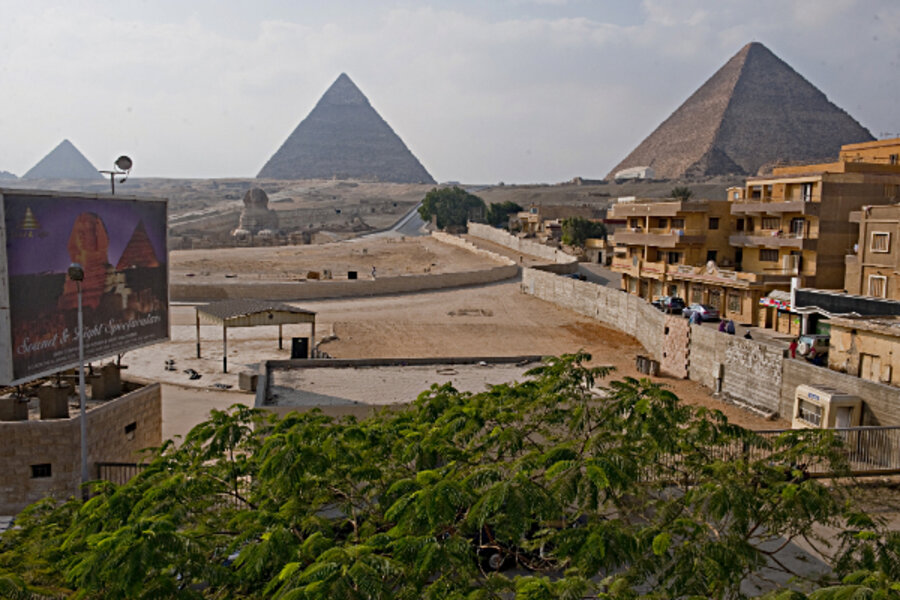The view of Egypt's protests from the pyramids, with hardly a tourist in sight
Loading...
| Cairo
The camel drivers whose livings rely on coaxing tourists onto their grunting, spitting beasts for photos before the pyramids of Giza, just outside of Cairo, have a lot to be upset about.
Tourist season has been shut down by the panicked flight of tens of thousands of tourists from the country since unprecedented democracy protests calling for the downfall of President Hosni Mubarak erupted on Jan. 25.
Egypt’s ongoing uprising has captivated a broad swath of Egyptians, and was given renewed vigor today by the release of young Google executive Wael Ghonim. But the view of the protests from Giza is a complex mixture of pride, fear of instability, and seemingly contradictory positions.
Take the group of men sitting in a largely deserted coffee shop across from the pyramids. Ali Ibrahim is the third generation in his family to peddle rides to tourists, and he frets that he’ll have to sell his camels Ali Baba and Mary in a few weeks because he won’t have the $10 a day it requires to feed them.
But he’s not angry at the protesters at all.
“This uprising was generated by the corruption in our society,” he says. “I have to pay bribes every day just so I can work. So I support the youths. They should stay in Tahrir Square until we’ve got our rights, [until we] get democracy. But I’m worried about some of the foreigners mixing in.”
A friend of his, who works as an informal guide to tourists and only wants to be called Mohamed, interrupts. “The corruption here is killing me; most of what I make goes to the police,” he says. “So good for the students. But I support Mubarak, too. He should be president forever. And now there are too many foreigners manipulating things at Tahrir – Iran, Libya, Israel all have a hand.”
NDP officials reportedly paid, recruited camel owners
State TV and government officials like new Vice President Omar Suleiman have been warning about foreign infiltrators at Tahrir for the past week. They suggest that Egypt’s democracy protests have been engineered by forces hostile to Egypt.
The Monitor has seen no signs of anyone but Egyptians and foreign reporters present, but the regime's propaganda has been effective with many people, creating a xenophobic atmosphere in a country whose economy relies on foreign tourism.
Mohamed asserts that on the most violent day of the demonstrations, when a small group of men on horseback and camels charged at the pro-democracy protesters in Tahrir Square, an official from the ruling National Democratic Party encouraged them to take part.
He claims that in the first few days of the protests, the official distributed money to horse and camel owners to make up for lost income. Then he came and said he couldn’t afford it anymore, and suggested they head to Tahrir. “If you want to end this thing and get back to work, why don’t you do something about it?”
Another man elsewhere in Giza later told precisely the same story, but its truthfulness could not be confirmed.
Half of tourist high season lost already
Tourism is clearly going to take a hammer blow this year. The tourist high-season between December and April, which provides most of the year's income to legions of Egyptians from Giza to Luxor to Aswan in the far south, has been cut in half.
At the entrance to the Giza plateau, where ordinarily thousands of American, German, and Russian tourists would have been streaming down from the Great Pyramid of Cheops and under the absent nose of the Sphinx to make their way back to their hotels, there were just two tourists present, hanging on the fence that has kept them away from the monuments since Jan. 26.
Zack Davisson says he and his wife Miyuki arrived in Egypt on Jan. 24, just as the protests broke out. Within a day, access to the famed temple of Abu Simbel near Aswan in Southern Egypt was shut down.
They made their way to Luxor, where they wandered alone through Karnak temple, and then on to Giza, where they’ve been rebuffed from seeing the pyramids and the Sphinx by armored personnel carriers and armed soldiers at the gate.
'Our heritage ensures the tourists will come back'
The men in the local tourist trade are anxious, and worried about their future. They’re also confused about what’s coming next. But no simple answers are forthcoming when asked about whether the protesters should go home, continue to press their demands for an end to one-party rule here, or something in between.
Gomaa Saber al-Gabri tends to take a long view. Sitting cross-legged in his carpet shop, his white skull cap, immaculate robe-like galabiya, and large prayer callous on his forehead make him look an Egyptian merchant from central casting.
“The youths are still in that square because they don’t trust the government – and I don’t blame them,” he says. “But they’ve gotten a lot of concessions. They’re going to give up some, and when they go home we’ll get back to business. Our heritage ensures that the tourists will always come back.”






